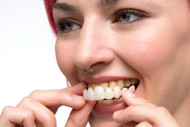How much does it cost to replace a missing tooth?
The cost of a missing tooth is determined by the type of replacement, the number of teeth that need replacing, and even your location.
Dental implants, bridges, and partial dentures are all effective replacements for missing teeth that can last for many years. While some health insurance policies may cover at least part of the cost of replacement, and some dental offices offer payment or financing plans to help with the rest, it can be a huge investment for many patients.
But are there any cheaper alternatives?
Let’s take a look.
Total cost of a single tooth replacement
The average cost of a single tooth replacement is between $3,000 and $4,500 in the US - depending on the price of the consultation, additional services and preparatory work, and the chosen tooth replacement method.
Costs and Options for Single Tooth Replacement
Dental implants are the preferred treatment options for adults who have lost a permanent tooth. The main benefit of implants is that they resemble natural teeth in appearance and function. They're also less difficult to keep clean, which is good for the gums and bone structure.
Replacement of missing teeth: what is the best option?
So, what is the most efficient method of tooth replacement?
Dentists will tell you that it depends on the state of your teeth, asking you questions like:
- How many missing teeth do you have?
- How old are you?
- Are you experiencing any kind of discomfort or pain?
From there, they will recommend the most suitable option for you.

Tooth replacement options
Dental implants
Dental implants are an excellent way to replace a single or multiple missing teeth
A titanium root is surgically implanted into your jawbone with dental implants before a crown is secured over the top to create the appearance of a full and healthy smile.
Dental implants can last a lifetime, look natural, and have no negative effects on neighboring teeth if properly installed.
However, they do require a lengthy surgical procedure and recovery time, with multiple dentist visits. Typically, it takes 3-6 months to complete from the initial consultation to placement, considering healing time and unique circumstances.

Dental bridge
A dental bridge is another option for replacing a missing tooth, teeth, or even a missing front tooth. A bridge effectively bridges the gap between one or more missing teeth by connecting a replacement tooth to healthy teeth on either side.
It’s made up of custom-made crowns for your teeth and secured to the teeth on either side of the gap. The most common materials used to fill the gap are ceramic and porcelain fused to metal alloys or gold.
They are used to replace the missing support for a prosthetic tooth, significantly improving the patient's facial symmetry and bite.
While effective and favored by many, there are a few drawbacks to consider. To maintain the look and overall health of your new smile, a strict oral hygiene routine is mandatory to stick to, otherwise, the risk of decay and gum disease is much higher.
Partial denture
Another option for replacing single or multiple missing teeth is a partial denture. This is a removable option that clasps to the adjacent natural teeth, for a full and natural-looking smile.
These teeth are made of synthetic materials that look and feel like natural teeth. Some partial dentures may have precise attachments to your natural teeth, making them more stable and comfortable.
The main drawback of partial dentures is that they are a non-permanent method that can feel uncomfortable, causing difficulty in speaking and chewing, and sore gums. Similarly to a bridge, if not cleaned and maintained as advised, bacteria can build up and cause infections.

Complete denture
Complete dentures cover the entire arch of a person's teeth. Complete dentures can be made for either the top or bottom of your mouth (or both!) and are used for various reasons.
If the natural teeth cannot be saved, only complete dentures should be used to improve bite, chewing ability, and speech. If the natural teeth cannot be saved - in the case of gum disease or tooth decay - only complete dentures should be used.
When dentures are first installed, they can take a lot of getting used to, affecting speech, eating, and the overall facial structure. Like most solutions for missing teeth, it’s vital that they are cleaned thoroughly and regularly to prevent infections and bad breath from developing. As you can’t take them out, a new, and much longer oral hygiene routine is advised.
Snap-on veneers
While cosmetic dentistry procedures are highly effective, they aren’t cheap. Luckily, instasmile snap-on veneers offer the same premium look and feel for a fraction of the cost.
Made bespoke to your measurements and shade preference, you can enjoy a full and even smile that you can wear comfortably all day or all night.
With no need for surgery, or visits to your dentist - thanks to our at-home smile assessment and impression process - you can have your new smile in no time.
They’re easy to clean too. Just warm water and a soft-bristled toothbrush are needed to remove any debris from the day, keeping them clean and hygienic. To further remove any unseen bacteria, you can soak them in denture crystals for a few minutes 1-2 times per week depending on how often you wear them.

Cover missing teeth with instasmile
Want to create a full smile without the cost?
Consider instasmile snap-on veneers.
Purse-friendly, effective, and can be delivered right to your door.
Complete an online smile assessment now to get started!
Frequently Asked Questions






 UK
UK
 USA
USA
 Australia
Australia

